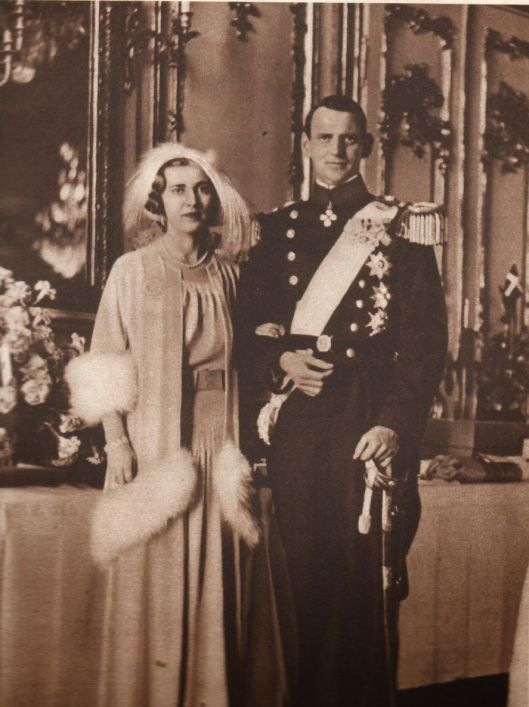Tags
Frederik IX of Denmark, Gustaf VI Adolph of Sweden, King Edward VIII of the United Kingdom, Louise Mountbatten, Prince Arthur Duke of Connaught, Princess Ingrid of Sweden, Princess Margaret of Connaught, Queen Ingrid of Denmark, Queen Margrethe II of Denmark., Queen Victoria of the United Kingdom
Ingrid of Sweden (Ingrid Victoria Sofia Louise Margareta; March 28, 1910 – November 7, 2000).

She is pictured here with her daughters Queen Margrethe II and Princess Benedikte of Denmark and Queen Anne-Marie of the Hellenes on her 90th birthday.
She died eight months later.
Born into the House of Bernadotte Princess Ingrid was born on March 28, 1910, at the Royal Palace in Stockholm as the third child and only daughter of Gustaf Adolf, Crown Prince of Sweden and his first wife, Princess Margaret of Connaught. Her father was the eldest son of King Gustaf V of Sweden by his wife, Princess Victoria of Baden. Her mother was a daughter of Queen Victoria’s third son Prince Arthur, Duke of Connaught and Strathearn by his wife Princess Louise Margaret of Prussia.

Princess Margaret of Connaught
In 1920, when Ingrid was just ten years old, her mother died after undergoing mastoid surgery while in the eighth month of her sixth pregnancy. After her mother’s death, Ingrid spent several months of each year in the United Kingdom in the care of her grandfather. Observers suggested that Ingrid’s strong self-discipline was shaped as an effect of her mother’s death. Her father remarried Lady Louise Mountbatten three years later. Louise was a second cousin of Ingrid’s.

Princess Ingrid (far right) with her father, mother and three brothers in 1912.
Her step-mother, Louise, was born a princess of Battenberg. Her father, Prince Louis of Battenberg, who was an admiral in the British Royal Navy, renounced his German title during the First World War and anglicised his family name to “Mountbatten” at the behest of King George V. From 1917, therefore, his daughter was known as “Lady Louise Mountbatten”. Her mother was Princess Victoria of Hesse and by Rhine, a granddaughter of Queen Victoria. Louise was a sister of Louis Mountbatten, 1st Earl Mountbatten of Burma, and of Princess Alice of Battenberg, who was the mother of Prince Philip, Duke of Edinburgh. She was also a niece of Empress Alexandra Feodorovna of Russia.
Only a stillborn daughter resulted from her father’s second marriage. Ingrid felt betrayed by her father when he remarried, and she was unkind to Crown Princess Louise. Ingrid and her father would not reconcile until many years later.
The question of Ingrid’s marriage was a hot topic of conversation in the 1920s. She was matched with various foreign royalties and was seen by some as a possible wife for the heir-apparent to the British throne, the Prince of Wales, (future King Edward VIII) who was her second cousin. Her mother, Margaret of Connaught, and the then-Prince of Wales’ father, King George V, were first cousins, both being grandchildren of Queen Victoria. In 1928, Ingrid met the Prince of Wales in London. However, no engagement took place.

On March 15, 1935, shortly before her 25th birthday, she was engaged to Frederik, Crown Prince of Denmark and Iceland. They were related in several ways. As descendants of Oscar I of Sweden, they were third cousins. Through Leopold, Grand Duke of Baden, they were third cousins. And finally through Paul I of Russia, Frederik was a fourth cousin of Ingrid’s mother. They married in Stockholm Cathedral on May 24, 1935. Among the wedding guests were the King Christian X and Queen Alexandrine of Denmark, the King Leopold III and Queen Astrid of the Belgians and the Crown Prince Olav and Crown Princess Märtha of Norway.
During the German occupation of Denmark in World War II, Ingrid, with her personal courage and integrity, influenced the Danish Royal House and its conduct in relation to the occupation forces, and won great popularity as a symbol of silent resistance and public patriotic moral. She showed solidarity toward the Danish population, and could often be seen on her bicycle or with her baby carriage on the streets of Copenhagen during the war.
Her open defiance of the occupation forces made her grandfather, King Gustaf V of Sweden, worry about the risks, and in 1941, he sent a demand to her to be more discreet “for the sake of the dynasty” and its safety, but she reacted with anger and refused to obey, and she had the support of her spouse, who shared her views. One display of defiance shown by Ingrid was her positioning of the flags of Denmark, Sweden and the United Kingdom in the window of the nursery at Amalienborg, the royal residence in the centre of Copenhagen.

King Frederik IX and Queen Ingrid of Denmark
Upon her husband’s accession to the throne on April 20, 1947, as King Frederik IX of Denmark she became the Queen of Denmark. As such, she reformed the traditions of Danish court life, abolished many old-fashioned customs at court and created a more relaxed atmosphere at official receptions.
In 1972, King Frederick IX died, and Ingrid was widowed at the age of 61. Her elder daughter, aged 31, became the new queen, Margrethe II, and Ingrid now assumed a position as family matriarch. That same year, after having sworn to respect the Danish constitution, she was appointed Rigsforstander (formal Regent) and representative of the monarch whenever her daughter (and later her grandsons) were absent, a task she performed on many occasions. This was exceptional; since the constitution of 1871, only the Crown Prince had been allowed to act as regent in the absence of the monarch.

Queen Ingrid died on November 7, 2000 at Fredensborg Palace, Fredensborg, with her three daughters—Queen Margrethe II, Princess Benedikte and Queen Anne-Marie of Greece—and ten grandchildren at her bedside. Thousands gathered outside Amalienborg Palace, her official residence, after her death was announced; flowers were left, candles were lit and hymns were sung in her honour.
